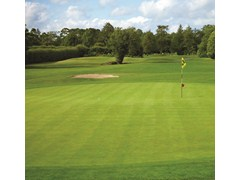
Keep active moving for summer turf disease control
Greenkeepers in Sweden have reported early attacks of Anthracnose this season, triggered by temperatures of over 20°C around Stockholm in May, putting recovering turf grass under additional pressure. With the pathogen now endemic in most fine turf surfaces, any increased stress could lead to further outbreaks, warns Lars Tveter of Syngenta.
"Many types of stress predispose turf to Anthracnose outbreaks, including drought, inadequate nitrogen, insect or nematode feeding. Excessively low cutting heights, nutritional deficiency and compaction can make turf particularly susceptible to attack," he advised. "Anthracnose is most severe on annual meadow-grass, but the foliar form of the disease affects most turf grass species, including Bentgrass and Fescue."
When turf is under stress over the summer, Lars urged greenkeepers and advisors that a preventative fungicide application and nutritional input before symptoms are seen is crucial to maintain turf quality. "During summer growth, the systemic activity of Headway is key to keeping fungicide in the leaf and protecting the new growth; at this time of year a contact or local penetrant fungicide could be completely removed by mowing in just a couple of days.
"Importantly, the systemic movement within the leaf ensures the fungicide is present at the cut tip that is most susceptible to infection," he pointed out. Furthermore, active recycling of Headway means that when the leaf is cut by mowing, any exudate that runs down the leaf, or is washed off by irrigation, will be reabsorbed by the leaf or root and further build the reservoir of long-term disease protection within the plant.
Additionally, Lars highlighted that turf managers should be taking all possible measures to alleviate stress, such as raising cutting height, ensuring there is sufficient moisture and, where appropriate, aeration to relieve compaction.
He further stressed the crucial importance of providing plants with adequate nutrition, advocating a high-quality liquid fertiliser should be tank-mixed with any anthracnose fungicide treatment, to provide a source of nutrients to maintain turf health. Trials have shown a significant improvement in disease control when readily-available fertiliser is included with fungicide treatments.
Primo Maxx programmes on greens and fairways will also help limit the effects of stress, as well as reducing mowing frequency and the volume of clippings removed that will help to prolong the efficacy of fungicide treatments, he added.
Headway may be tank-mixed with Primo Maxx treatments to save time and costs; however, greenkeepers should not compromise the importance of fungicide timing if conditions are favourable for disease.
Lars highlighted that early summer Headway applications can also provide valuable protection against outbreaks of Take-All that are becoming increasingly prevalent on golf course fairways and greens.
"The visual effects and impact on surface quality makes Take-All one of the most damaging summer turf diseases. It can take months and repeated over sowing operations to restore. If it is left untreated, is almost inevitably going to reoccur when conditions are right." The recommendation for areas susceptible to Take-All is typically two treatments of Headway, applied with a two week interval when there are risk conditions.
Research in the US, led by Dr Mike Fidanza of Penn State University, indicated that applying fungicide in sequence with a wetting agent can further enhance control of soil-borne fungal diseases. New Syngenta trials this year will include Qualibra and Headway treatments targeted at root zone treatments.
Greenkeepers and turf managers can receive up to date advice on control of Anthracnose and Take-All - along with a wealth of other valuable turf management advice and information - on the website www.greencast.se
